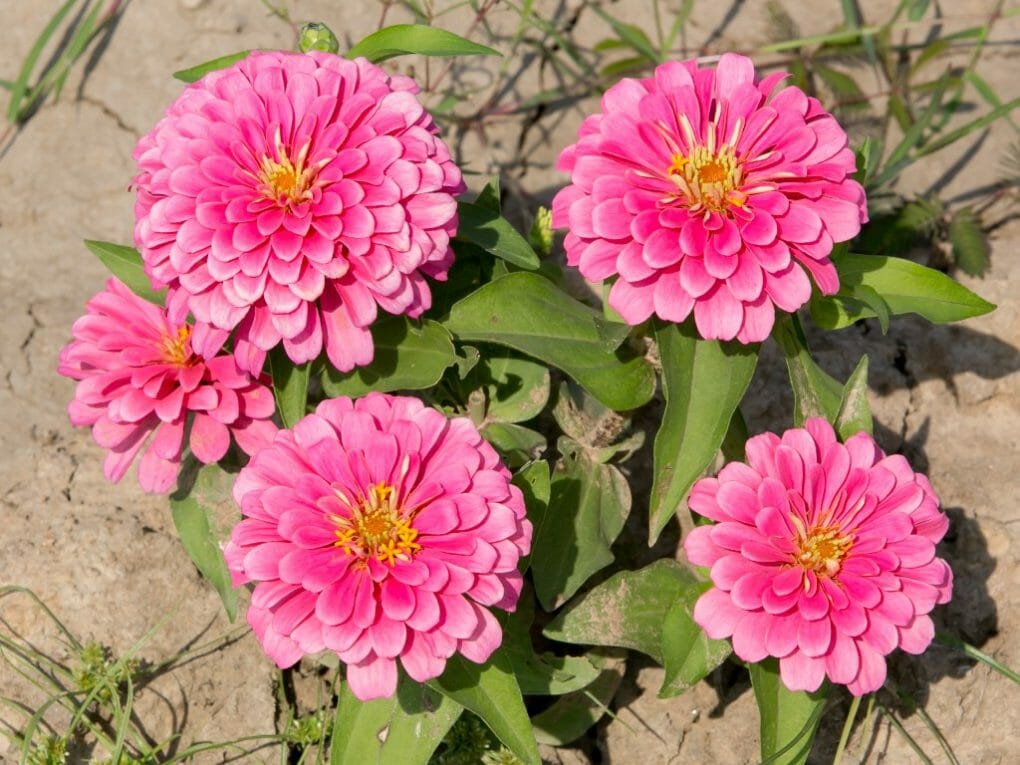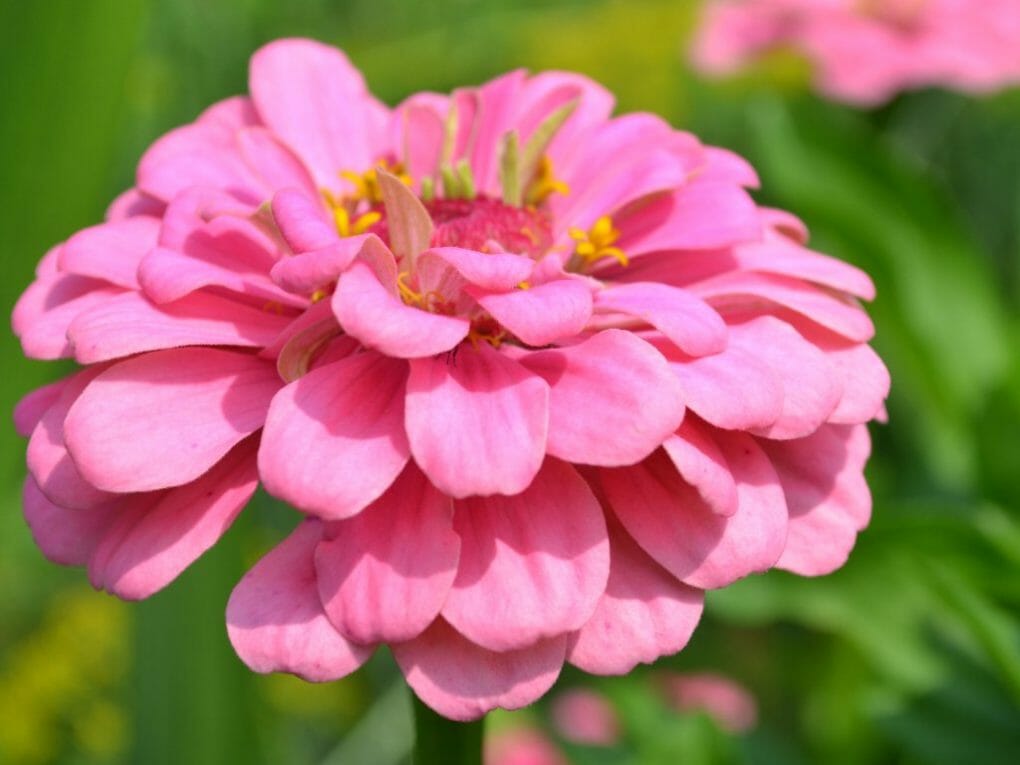Does Zinnia Need Full Sun? Know How Many Sun Hours Do Zinnias Require

Zinnias thrive when planted in full sun. They are sun-loving and heat-tolerant. Summer is their favorite season because it delivers the most sunlight imaginable. Additionally, they love to bloom at temperatures about 90°F (32°C). For these two reasons, offering zinnias as much sunlight as possible is advisable. Unlike irises, zinnias thrive in the south and west-facing plants due to their high tolerance for heat.
Zinnias come from Mexico. They are tender annuals, which means they die when it gets cold. After the last frost date, zinnia seeds or seedlings can be planted. From germination to maturity, which can take anywhere from 8 to 12 weeks, the time is short. In the north, where temperatures are chilly and the growing season is short, plants can be started indoors and nurtured under powerful lights for three to four weeks. This is because zinnia seeds need light to sprout. While flowers bloom, new buds grow, so taking off the flowers keeps the plants blooming. You can also get flowers all the time if you plant seeds every two weeks. Even though zinnias like heat and can grow in dry conditions, they bloom best when they are watered when it is hot and dry.
Table of Contents
How Many Sun Hours Do Zinnias Require?
They require as much sunlight as possible, with a minimum of six hours of daily sunlight. When planning your zinnia garden beds, select a highly sunny area for your zinnia seeds and plant zinnias in a spot where the eventual zinnia blooms will receive the most daily sunlight. A planting bed with a southern or western orientation will give the best results. Full light is required for abundant blooms of vibrant color on your zinnias.
You can grow zinnias in less than six hours of full sun every day, but they might have fewer flowers and grow smaller if they get even a little shade. If you want to grow garden zinnias (Zinnia elegans) that are 4 feet tall, you should give them as much sun and light as possible during the rest of a long summer day. Powdery mildew, a fungal disease that grows in cool, humid places with poor airflow, is another thing to worry about when planting zinnias in part shade.
If you read the instructions for planting zinnias (Zinnia spp.) on the back of a seed packet or a plant tab in a cell pack from a nursery, they will probably say to plant them in full sun. But there can be different differences between full sun and part shade. From 8 a.m. to 4 p.m., your annual garden can soak up the sun. 8 p.m. But your neighbor’s yard doesn’t get full sun until 10 a.m. to 4 p.m. — Zinnias can grow well in either one. A part-shade garden gets less than six hours of sun each day. Shade can be dappled, light, or full, depending on what’s blocking the sun, like a deciduous tree, hedge, building, or canopy of evergreens. However, for an area to be considered full sun, it must get at least six hours of unobstructed sun daily.
Can Zinnias Thrive Indoor?
Zinnias can tolerate a minimal amount of partial shade, hindering their development. Even moderate afternoon shade will prevent zinnias from producing their renowned beauty. To compensate for the absence of direct sunshine:
- Provide at least eight hours of indirect sunlight per day.
- Plant your zinnias in transparent containers.
- Place this container in a light area like a window facing south.
- Ensure that your zinnias receive at least 8 hours of indirect sunshine for optimal growth.
- Keep zinnia plants in the brightest part of your yard for the greatest results.
Even the tiniest amount of shade will impede your zinnias’ growth. To ensure that your zinnias have the best access to full sun, you should routinely clear away any foliage above them. Routinely remove any foliage that could prevent your zinnias from receiving sunlight. If you do not remove the canopy and eliminate shade, you will not be able to view any of these amazing hues. Zinnias thrive in sunny garden beds with no adjacent trees or plants that provide shade.
What Happens if Zinnias Do Not Receive Sufficient Sun?
Your zinnias will experience health difficulties due to a lack of sunlight. Zinnias planted in the shade will be more prone to fungal disease problems and increases the risk of leaf spots and bacterial illness in zinnias. In addition, the flower heads of zinnias will struggle to bloom in the shadow, and bacterial wilt may kill your plant. They will weaken and possibly perish. Keep a look out for white patches and flimsy stems; these are indications of weakened zinnias. To avoid these difficulties, ensure that your zinnias receive ample light. If your zinnias have gone without sun for over a few cloudy days, examine them for fungal patches and powdery mildew.
Can Zinnias Receive Excessive Sun?
There is essentially no such thing as too much sun for most zinnia varieties. Moreover, zinnias thrive in the intense heat of warmer locations. In addition to being tolerant of temperatures below 100°F (82°C), they often prefer temperatures over 90°F (32°C) for flowering. Plant zinnias in the hottest areas of your garden, south or west facing.
Be certain to water zinnias frequently in extreme heat. Add mulch to your zinnias to maintain soil moisture during dry circumstances. The one exception is that zinnias require damp soil for optimal growth. Ensure your zinnias are well-watered in extreme heat and dry weather. Add a layer of organic mulch around your plants at least two to three inches (5 to 7.5 cm) deep. Straw works wonderfully as an organic mulch. The highest yield of zinnia flowers is guaranteed when the soil is hot and moist.
Why Does Zinnia Loves Sun?

There are a few reasons why zinnias love the sun. Firstly, sunlight provides energy to the plant, which helps it grow and blossom. Secondly, sunlight stimulates photosynthesis, the process by which plants make food from carbon dioxide and water. This is essential for zinnia production as they need lots of nitrogen fertilizer to help support flowering success. Lastly, an overabundance of the sun can scorch leaves, so they cannot photosynthesize properly. This is especially problematic when growing in containers or raised beds since shade will prevent full exposure to direct sunlight.
The full sun is great for these plants because it helps their cells, called chloroplasts, make carbs and sugars. The green color of this plant comes from the chlorophyll in these cells. The carbs make it easier for plants to turn the nutrients into plant tissue. Annual plants like zinnias, which grow quickly and bloom continuously, need a steady supply of carbohydrates from photosynthesis. When there aren’t enough carbohydrates, there are fewer flowers at first and less growth over time. Photosynthesis gives the plant a steady supply of carbs, which makes it grow and bloom more. Because of this, zinnias need a lot of sun.
